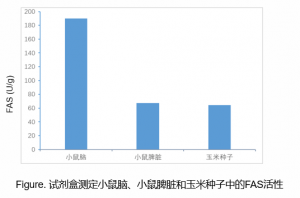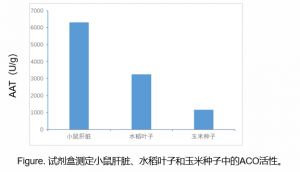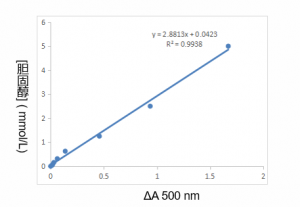New products have been added to fatty acid metabolism series
Previously, we provided detailed knowledge about fatty acid metabolism, including fatty acid anabolism and catabolism, and also introduced two biochemical indicators related to fatty acid metabolism, including:
1.fatty acid synthase
Fatty acid synthase (FAS) is a multifunctional homodimeric enzyme protein that is the primary enzyme required for the anabolic conversion of dietary carbohydrates to fatty acids. Fatty acid synthase catalyzes the conversion of acetyl coenzyme A and malonyl coenzyme A to long-chain saturated fatty acids in the presence of NADPH. Human fatty acid synthase is a large homodimeric multifunctional enzyme for the synthesis of palmitic acid. The unique carboxy-terminal thioesterase structural domain of fatty acid synthase hydrolyzes the growing fatty acid chains and plays a key role in regulating the length of the released fatty acid chains. In addition, the upregulation of human fatty acid synthase in a variety of cancers makes thioesterase a candidate target for therapeutic treatment. Fatty acid synthases of animal tissues are complex multifunctional enzymes composed of two identical monomers.
Significance of determination of FAS: FAS is a key enzyme in fatty acid synthesis, which catalyzes acetyl-CoA and malonyl-CoA to produce long-chain fatty acids. FAS is widely expressed in various tissues and cells, and is abundantly expressed in mammalian liver, kidney, brain, lung, mammary gland and adipose tissue.
Principle of FAS determination:The principle is that FAS catalyzes the formation of long-chain fatty acids from acetyl CoA, malonyl CoA and NADPH, and NADP+;NADPH has an absorption peak at 340 nm, but NADP+ does not, and the FAS activity is calculated by measuring the light absorption decline rate of 340 nm.
Test data:

Figure Determination of FAS activity in Mouse brain, Mouse spleen and Maize seed by Kit
2.Alcohol Acyltransferase(AAT)
Significance of AAT determination: acyltransferases (AAT) are a large family of multifunctional proteins, which are mainly responsible for catalyzing various acylation and deacylation reactions in organisms, and play an important role in gene expression, metabolism and signal transduction.
The determination principle of AAT: AAT catalyzes acetyl CoA to transfer acetyl to butanol, while reducing DTNB to form TNB;TNB has an absorption peak at 412 nm. The increasing rate of absorbance of 412 nm is measured to calculate the AAT activity.
Test data:

Figure Determination of ACO activity in Mouse liver, Rice leaves and Maize Seeds by Kit
This time, there are two new members of our fatty acid family. The following will introduce them to you one by one. They are:
1.High Density Lipoprotein Cholesterol (HDL-C) Colorimetric Assay Kit
Significance of determination of high density lipoprotein (HDL-C): High density lipoprotein (HDL) is one of the serum proteins, which is mainly synthesized by the liver, carries cholesterol in the surrounding tissue, and then is converted into bile acid or excreted directly from the intestine through bile. It is a kind of anti-atherosclerotic plasma lipoprotein and a protective factor for coronary heart disease, commonly known as "vascular scavenger". It is an important reference index for the clinical diagnosis of coronary heart disease.
Principle of determination of high density lipoprotein (HDL-C): The high-density lipoprotein cholesterol in serum was separated with a precipitant, and cholesterol ester was hydrolyzed by cholesterol esterase to generate free cholesterol (FC) and free fatty acid (FFA), thereby converting cholesterol ester to FC; further, cholesterol oxidase was used to catalyze the oxidation of FC. , generate △4-cholestenone and H2O2; then use peroxidase to catalyze H2O2 to oxidize 4-aminoantipyrine and phenol to generate red quinone compounds; there is a characteristic absorption peak at 500nm.
2.Low density lipoprotein (LDL-C) content detection kit
Significance of determination of low density lipoprotein (LDL-C): Low-density lipoprotein is one of serum proteins, mainly synthesized by the liver, and is a lipoprotein particle that carries cholesterol into peripheral tissue cells. Low-density lipoprotein can enter the arterial wall cells and carry cholesterol, and can also be oxidized to oxidized low-density lipoprotein. When low density lipoprotein, especially oxidatively modified low density lipoprotein (OX-LDL) is in excess, the cholesterol it carries will accumulate on the arterial wall, and it is easy to cause arteriosclerosis for a long time. Therefore LDL is called "bad cholesterol". Low-density lipoprotein is positively correlated with the occurrence of coronary heart disease and atherosclerotic damage, and is an important indicator for lipid disease classification and risk prediction.
Principle of determination of low density lipoprotein (LDL-C): The low-density lipoprotein cholesterol in serum is separated with a precipitant, and cholesterol esterase is used to catalyze the hydrolysis of cholesterol ester to generate free cholesterol (FC) and free fatty acid (FFA), thereby converting cholesterol ester to FC; further use cholesterol oxidase to catalyze the oxidation of FC , generate △4-cholestenone and H2O2; then use peroxidase to catalyze H2O2 to oxidize 4-aminoantipyrine and phenol to generate red quinone compounds; there is a characteristic absorption peak at 500nm.
Test data:

Figure. Standard Curve of Cholesterol in 96-well plate assay–data provided for demonstration purposes only. A new standard Curve must be generated for each assay
Product recommendation
| Cat. No. | Product name | Size | Price($) |
| KTB2240 | CheKine™ Fatty Acid Synthetase(FAS) Activity Colorimetric Assay Kit | 48T/96T | 799/1099 |
| KTB1560 | CheKine™ Alcohol Acyltransferase(AAT)Activity Colorimetric Assay Kit | 48T/96T | 799/999 |
| KTB2250 | CheKine™ High Density Lipoprotein Cholesterol (HDL-C) Colorimetric Assay Kit | 48T/96T | 89/119 |
| KTB2260 | CheKine™ Low Density Lipoprotein Cholesterol (LDL-C) Colorimetric Assay Kit | 48T/96T | 89/119 |

Cell and protein research tools
Abbkine focuses on the fields of proteinology and cytology, and is committed to the innovation and research and development of various antibodies, proteins, analytical reagents and kits, in order to become a key promoter in the development of life science research, drug development and other fields. We provide you with the favorite products of protein and immune research users, from basic immunological products, such as protein extraction and quantification, to internal reference label antibodies, primary antibodies and secondary antibodies for immunological experiments; the favorite products of cell research users, from Dyes and kits for detecting cell status, organelle extraction kits, cell substructure staining and tracking and cell metabolism detection products, to cytokine and protein detection kits for cell culture, just to help your research career !











